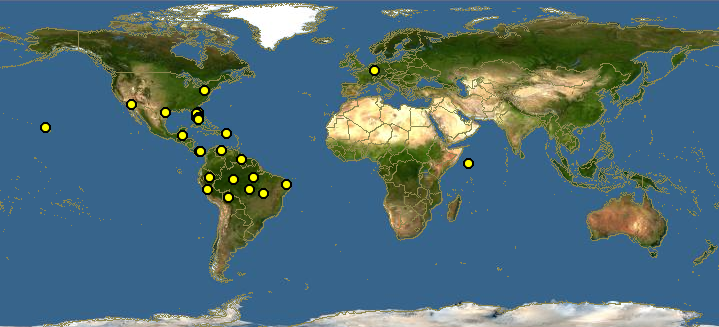Peacock bass is one of the most beautiful fresh water (and slightly saltwater) species of fish I have ever caught in my life. I personally caught Sargento (common name in Panamá) in Lago Gatún, Panamá and I can surely say it's really spectacular fishing because of top water fishing method. In clean water you can clearly see when fish launch to chase after the popper and hits it then jumps during towing. It's really exciting to feel and see. As I mentioned before it's appearance is beautiful because of the colors and shape of the body and fins. I highly recommend this type of fishing to everyone who would like to start his journey with fishing passion or just hobby because of its facility and fun. Definitely one of my favorite fishing targets especially in amazing place as Gatún lake in Panamá is.
Before you are going to watch the video I want you to read short information about this fish.
Peacock Bass or Pez Sargento (Spanish) (Latin: Cichla ocellaris, Bloch & Schneider, 1801)
Classification
Kingdom: Animalia
Phylum: Chordata
Class: Actinopterygii
Order: Perciformes
Family: Cichlidae
Genus: Cichla
Species: Cichla ocellaris
Distribution
North America: Florida in USA.
South America: Marowijne drainage in Suriname and French Guiana to the Essequibo drainage in Guyana.
Central America: Gatún lake in Panamá (introduced).
In addition Peacock Bass was introduced to few other places in the world.

Size / Weigh
Max length : 74.0 cm;
Max published weight: 6.8 kg (15.0 lb)
Environment
Freshwater; brackish (salty water);
benthopelagic; depth range 5 to ~10 m.
Tropical: 24°C - 27°C;
Short description
The speckled peacock bass is the largest species and can grow to 1 m (3.3 ft) in length, and may be the largest of all cichlid fishes. Most display a color pattern based on a theme of three wide vertical stripes on their bodies, sometimes with smaller intermediate bands, only a grey, brown, yellow, or green background. They also exhibit a spot on their tail fins that resembles the eyes on a peacock's tail feathers—a feature which resulted in their common names (this "ocellus" is a common feature of South American cichlids, and is thought to deter predators and fin-biting piranhas). In addition, many adult fishes (primarily males, but also some females) develop a pronounced hump on their foreheads shortly before and during the rainy season, when the fishes generally spawn. Other physical traits can vary greatly, depending on the species, individual and stage of development.
Biology
Occurs in the rapids, in quiet waters with medium depth and rocky substrates . Forms schools. Feeds only on small fish, especially threadfin shad, mosquito fish, tilapias, bluegills and all minnows. Not considered ideal for aquaculture due to its highly predatory habits. Reproduction occurs year-round, with a peak at the start of the rainy season. About 9,000 to 15,000 eggs per kg are released during spawning. Spawning takes place every two months on a flat stone in shallow water. The sticky eggs, measuring 1.4 mm in diameter, take 78 hours to hatch at 28°C.
Supporting source: http://www.fishbase.org
Video
STEEManians I want to especially thank for supporting:
@gregbit @margaretwise @glitterfart @hilarski @anahilarski @thearcanebear @mynameisbrian @choogirl @linzy13 @cecirod1218 @bibek @codypanama @donofa @fishdad
Here you can find some of my other posts/stories:
@edekadam/giant-trevally-hunting-for-birds-bbc-blue-planet-ii-video
@edekadam/fish-facts-16-jeremy-wade-feat-piraiba-lau-lau-video
Thanks for reading my posts if you like it feel free to vote and leave follow :)


